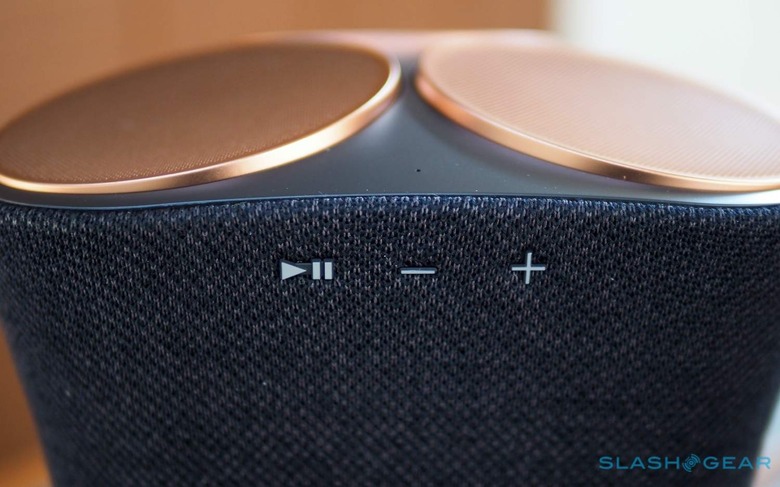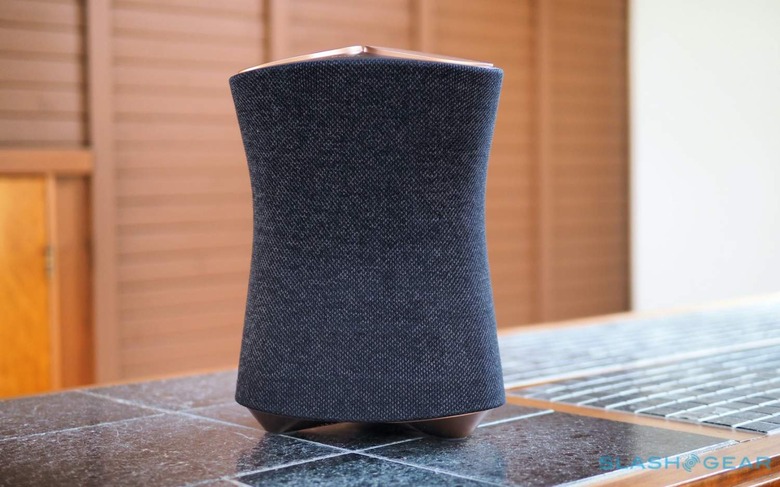Sony SRS-RA5000 Review: Taking An Expensive Risk On 360 Audio
- 360 Reality Audio has an impressive soundstage
- Room-filling party speaker
- Multiple options for wired and wireless sound
- Very expensive
- 360 audio tracks are in short supply
- Regular music lacks precision compared to rival speakers
- No AirPlay 2 support
- No battery and the power supply is big
The Sony SRS-RA5000 doesn't blend into a room, and neither does the 360 Reality Audio music its oddball design is all in aid of. The promise is intriguing: immersive music just as the artists and producers intended it to sound, and all from one – expensive – speaker. $700 gets you seats at the bleeding-edge of audio, but that's also a front-row view of the headaches a new format faces.
The RA5000 design is a little reminiscent of a shaver, mixed with hints of Alien egg. Not ugly, no, but at 13-inches tall definitely distinctive, and with Sony's gold highlights it's probably not going to blend into a space like some rival speakers might.

Inside there are three upward-firing drivers angled to bounce sound off the ceiling and walls, three mid speakers pointing out from the RA5000's midriff, and a subwoofer underneath. Each driver gets a separate channel from the 7-channel amp, and there's optional automatic volume adjustment to balance out mixed genre playlists. Auto sound calibration, meanwhile, uses a brief series of tones to adjust the EQ according to the acoustic qualities of the room.
While the sound may be designed to fill a space in 360-degrees, positioning can be tricky since the RA5000 is mains-powered. That means you'll need to run the cable somewhere you won't trip over it; it's a shame Sony couldn't find room for a battery inside. The cord itself isn't especially long, either, which also limits placement, and there's a separate – and large – power brick too. I'd have thought, given the size of the speaker overall, Sony could've squeezed that inside.

The controls are clustered on the upper edges, on two of the three sides. Touch-sensitive buttons take care of play/pause and volume on one edge, and power, input switching, and auto-calibration on the other. An NFC patch on the back supports Android quick-pairing.

That's one of a few options for piping music through the RA5000. There's a 3.5mm aux-in port, plus Bluetooth and WiFi, listed in escalating order of complexity. For Bluetooth, there's AAC and SBC codec support, and you can pair it to a recent Sony BRAVIA TV to bypass its built-in speakers. That only supports a single RA5000, however, so don't get any ideas of full surround sound.
WiFi promises higher quality, once you've futzed with the Sony app to get it on your home network. After that's done, you can link it to a Google Assistant or Amazon Alexa powered smart speaker for voice control and speaker grouping, and Sony integrates Chromecast support for wireless audio casting together with Spotify Connect. Conspicuous by its absence is AirPlay 2, which would've made using Apple devices a lot easier.

The biggest challenge, unsurprisingly, is finding content which makes the most of the Sony's charms. 360 Reality Audio music is still a rarity, and most streaming services don't offer it. Those that do – like TIDAL and Amazon Music HD – typically have a fairly small catalog of tracks in the format, and the subscription tiers with 360 tracks are more expensive than the basic package.
Figure on paying $14.99 per month for Amazon (or $12.99 if you're already a Prime subscriber), or $19.99 per month for TIDAL. Sony offers the audio equivalent of upscaling from regular music, but it's just not the same: things sound a little wider, but it's a blanket airiness rather than the more specific positioning of proper 360 Reality Audio tracks.

Find one of those tracks – and they need to be streamed over WiFi, not Bluetooth – and there's certainly a distinct audio effect. Sony likens it to sitting in a bubble of sound, though it's not quite so impactful. Definitely more spacious and fuller-sounding, though, and depending on the music itself you can pick out more directionality to the various elements.
In TIDAL, for example, I could switch between a Master recording (the highest-quality streaming the service provides) and a 360 Reality Audio version of the same track. The music using Sony's format had a wider, richer soundstage, and felt fuller than the high-quality stereo. Neither, though, delivered the focused slap of bass I was hoping for – and, frankly, expecting given the size of the RA5000 and its beefy power supply – with a lot of volume but a lack of precision.

You can tweak the EQ settings in Sony's app, though I struggled to get rid of some of the harsher sharpness from the high-end. Compared to a Sonos Five, the RA5000 may have filled the room more but I preferred the output from the Sonos. Sony's sounds more like a party speaker, pumping out maximum volume but sacrificing some clarity with it.
Sony SRS-RA5000 Verdict
360 Reality Audio is interesting, and – though not every track seems to take full advantage of the format's potential – it can be a really immersive way of listening to music. It's definitely worth doing some research before you open your wallet for the RA5000, however, because there's every chance that your favorite albums aren't going to be supported. That leaves you with standard stereo sound, and there Sony's speaker doesn't hold up to its $700 price tag.

Audiophiles will probably find clearer, more transparent ways to spend that money, while most other people will get more bang for their buck at Sonos or by finding leftover stock of Apple's discontinued HomePod. Two Sonos One or two HomePods set up in stereo pairs simply sounded better to my ears than a single RA5000, even if they couldn't match the 360 audio trick.
Right now, that's what 360 Reality Audio feels like: a clever trick. The frustration of actually finding compatible tracks dampens its charms, and the Sony SRS-RA5000's middling performance with more widely-available music can't quite compete with more traditional speaker rivals. Maybe time will address that content shortfall, but right now $700 seems a lot to risk on that happening.
